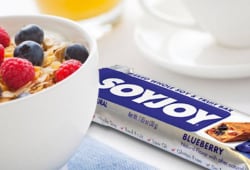As part of our snacking trends special edition, we caught up with Megan DeStefano, Global Strategic Marketing, at DuPont Nutrition & Health, a leading supplier of soy protein.
FNU: You’ve been researching snacking globally - what have you learned?
DeStefano: Recent DuPont Nutrition & Health research shows that globally, children consume two to three snacks per day. For American kids alone, snacking accounts for up to a quarter of children’s daily caloric intake. Snacking, and healthy, on-the-go snacking is a growing category around the world. In developed countries snacking is well established, but continues to grow and evolve, while countries with an emerging middle class, like China, India, and others, will see snacking as a new and fast growing category.
FNU: Are we getting enough nutritional bang for our snacking bucks considering how much we’re all snacking now?
DeStefano: Today too many children are snacking on empty calories, which in extreme cases can lead to obesity linked with malnutrition.
FNU: So what makes a better snack?
DeStefano: Offering snacks that provide greater satiety by way of higher protein and fiber content can help reduce daily caloric consumption, thereby making a contribution to the quality of children’s diets. Numerous studies have confirmed that protein and fiber induce a feeling of fullness, making it an essential player in efforts to manage and lose weight.
FNU: What’s a good source of protein for snacks?
DeStefano: Vegetable proteins should be considered as a lean, high quality source of protein for snacking. Sources of vegetable proteins are low in fat and saturated fat with no cholesterol. In addition, for those with intolerance to certain components of animal proteins, vegetable proteins provide no lactose. Vegetable protein is also more sustainable compared to animal-based proteins.
FNU: Pea, rice and other veggie proteins have stolen the limelight from soy lately. How can soy fight back?
DeStefano: Soy provides all the essential amino acids in the amount needed to support growth and development of children. Soy protein also has satiating properties that help support appetite control, which can help reduce overall food consumption. DuPont Nutrition & Health supported/collaborated on a recent study that showed that the replacement of a daily afternoon snack with a high-protein snack containing soy improved appetite in adolescents when compared to high-fat snacks.
In particular, soy protein-providing/containing foods may help reduce total cholesterol and LDL cholesterol. Research shows that when children and teens with high cholesterol levels consume soy protein instead of animal protein as part of low-fat diet, it helps reduce their total cholesterol and LDL cholesterol.

Read more about soy protein: Has soy lost its sparkle? Not from where we’re standing, says DuPont as it taps into high-protein craze
Click HERE to read about consumer research on snacking trends from Soyjoy unveiled at the Food & Nutrition Conference & Expo (FNCE) in Atlanta:
When snacking, 1,000 US consumers polled by SoyJoy in July claimed that they were looking for:
- Portability & convenience (73%)
- Calories (72%),
- A good source of protein (69%)
- Recognizable ingredients (65%)
- A good source of fiber (65%).
They also value the following attributes: A balance of nutrients (63%), all-natural ingredients (61%), non-GMO (56%), low-GI (37%), and gluten-free (28%), although an analysis of what people actually snack on suggests that they don't always practice what they preach.
Meanwhile, 82% of Americans say they regularly skip meals and replace them with snacks, said Soyjoy.
